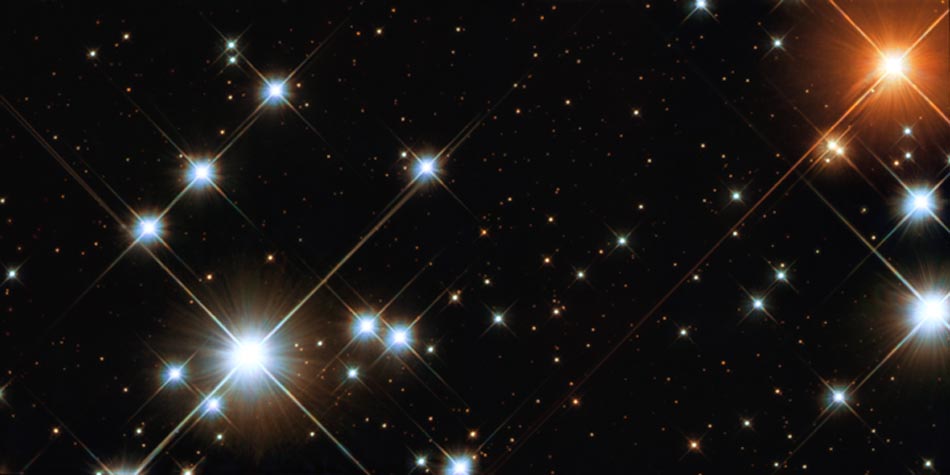
Description: Star Clusters
Position (J2000): RA 12h 53m 42.12s Dec -60° 22' 1.21"
Constellation: Crux
Distance: 6500 light years
Field of view: 2.51 x 1.24 arcminutes
Orientation: North is 35.3° right of vertical
Image Credit: NASA/ESA & Jesús Maíz Apellániz (Instituto de Astrofísica de Andalucía, Spain)
Release date: October 29, 2009
Related Images: Wide-field view ESO Close-up Hubble Close-up
ABOUT THIS IMAGE:
This
image is a "close-up" view from the NASA/ESA Hubble Space Telescope
of NGC 4755, or the Jewel Box cluster. Several very bright, pale blue
supergiant stars, a solitary ruby-red supergiant and a variety of other
brilliantly colored stars are visible in the image, as well as many much
fainter ones, often with intriguing colors. The huge variety in brightness
exists because the brighter stars are 15 to 20 times the mass of the Sun,
while the dim points are less than half the mass of the Sun. More massive
stars shine much more brilliantly. They also age faster and make the transition
to giant stars much more quickly than their faint, less-massive siblings.
The Jewel Box cluster is regarded as one of the finest objects in the
southern sky. It is visible with the naked eye with a visual magnitude
of 4.2. The Jewel Box cluster is impressive when viewed with binoculars
or a small or large telescope. It was given its nickname by the English
astronomer John Herschel in the 1830s because the striking color contrasts
of its pale blue and orange stars seen through a telescope reminded Herschel
of a piece of exotic jewelry The three brightest members of the cluster
lie in a straight line and are known as the 'traffic lights' due to their
varying colors.
The Jewel Box may be visually colorful in images taken on Earth, but observing
from space allows the NASA/ESA Hubble Space Telescope to capture light
of shorter wavelengths than can not be seen by telescopes on the ground.
This new Hubble image of the core of the cluster represents the first
comprehensive far ultraviolet to near-infrared image of an open galactic
cluster. It was created from images taken through seven filters, allowing
viewers to see details never seen before. It was taken near the end of
the long life of the Wide Field Planetary Camera 2 ? Hubble's workhorse
camera up until the recent Servicing Mission, when it was removed and
brought back to Earth. Several very bright, pale blue supergiant stars,
a solitary ruby-red supergiant and a variety of other brilliantly colored
stars are visible in the Hubble image, as well as many much fainter ones.
The intriguing colors of many of the stars result from their differing
intensities at different ultraviolet wavelengths.
The
Jewel Box cluster is about 6400 light-years away and is approximately
16 million years old.